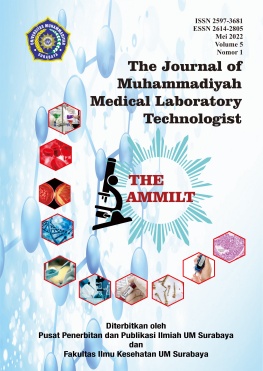Isi Artikel Utama
Abstrak
Rincian Artikel
Referensi
- Akgun, O. et al. (2020) ‘Does sampling saliva increase detection of SARS-CoV-2 by RT-PCR Comparing saliva with oro-nasopharyngeal swabs’, (January).
- Becker D., Sandoval E., Amin A., De Hoff P., Diets A., Leonetti N., L. Y. . and Elliott C., Laurent L., Grzymski J., L. J. (2020) ‘Saliva is less sensitive than nasopharyngeal swabs for COVID-19 detection in the community setting’.
- Butler-Laporte, G. et al. (2021) ‘Comparison of Saliva and Nasopharyngeal Swab Nucleic Acid Amplification Testing for Detection of SARS-CoV-2: A Systematic Review and Meta-analysis’, JAMA Internal Medicine, 181(3), pp. 353–360. doi: 10.1001/jamainternmed.2020.8876.
- Byrne, R. L. et al. (2020) ‘Saliva offers a sensitive, specific and non-invasive alternative to upper respiratory swabs for SARS-CoV-2 diagnosis.’, medRxiv, p. 2020.07.09.20149534. doi: 10.1101/2020.07.09.20149534.
- Caulley, L. et al. (2021) ‘Salivary detection of covid-19’, Annals of Internal Medicine, 174(1), pp. 131–133. doi: 10.7326/M20-4738.
- Hidayat, R. et al. (2011) ‘Metodologi Penelitian Psikodiagnostika’, 19(2), pp. 81–92.
- Huang, C. et al. (2020) ‘Clinical features of patients infected with 2019 novel coronavirus in Wuhan, China’, The Lancet, 395(January), pp. 497–506.
- Kadarman, J. T., Anggriyani, N. and Wiryawan, W. (2016) ‘PERBANDINGAN SENSITIVITAS DAN SPESIFISITAS ANKLE- BRACHIAL INDEX DENGAN CAROTID INTIMA-MEDIA THICKNESS DALAM MENDETEKSI PENYAKIT JANTUNG KORONER’, 5(4), pp. 1111–1124.
- Lai, A. L. et al. (2020) ‘COVID-19: towards controlling of a pandemic’, the Lancet, 395(April), p. 1315. doi: 10.1056/NEJMoa2002032.9.
- Lippi, G., Simundic, A. M. and Plebani, M. (2020) ‘Potential preanalytical and analytical vulnerabilities in the laboratory diagnosis of coronavirus disease 2019 (COVID-19)’, Clinical Chemistry and Laboratory Medicine, 58(7), pp. 1070–1076. doi: 10.1515/cclm-2020-0285.
- Miller, M. et al. (2020) ‘Validation of a Self-administrable, Saliva-based RT-qPCR Test Detecting SARS-CoV-’, pp. 1–18.
- To, K. K. et al. (2020) ‘Consistent Detection of 2019 Novel Coronavirus in Saliva’, (Xx Xxxx), pp. 4–6. doi: 10.1093/cid/ciaa149.
- Zion Congrave-Wilson, M. et al. (2021) ‘Change in Saliva RT-PCR Sensitivity Over the Course of SARS-CoV-2 Infection’, Annals of Internal Medicine, 174(9), pp. 1330–1332. doi: 10.7326/L21-0282.
Referensi
Akgun, O. et al. (2020) ‘Does sampling saliva increase detection of SARS-CoV-2 by RT-PCR Comparing saliva with oro-nasopharyngeal swabs’, (January).
Becker D., Sandoval E., Amin A., De Hoff P., Diets A., Leonetti N., L. Y. . and Elliott C., Laurent L., Grzymski J., L. J. (2020) ‘Saliva is less sensitive than nasopharyngeal swabs for COVID-19 detection in the community setting’.
Butler-Laporte, G. et al. (2021) ‘Comparison of Saliva and Nasopharyngeal Swab Nucleic Acid Amplification Testing for Detection of SARS-CoV-2: A Systematic Review and Meta-analysis’, JAMA Internal Medicine, 181(3), pp. 353–360. doi: 10.1001/jamainternmed.2020.8876.
Byrne, R. L. et al. (2020) ‘Saliva offers a sensitive, specific and non-invasive alternative to upper respiratory swabs for SARS-CoV-2 diagnosis.’, medRxiv, p. 2020.07.09.20149534. doi: 10.1101/2020.07.09.20149534.
Caulley, L. et al. (2021) ‘Salivary detection of covid-19’, Annals of Internal Medicine, 174(1), pp. 131–133. doi: 10.7326/M20-4738.
Hidayat, R. et al. (2011) ‘Metodologi Penelitian Psikodiagnostika’, 19(2), pp. 81–92.
Huang, C. et al. (2020) ‘Clinical features of patients infected with 2019 novel coronavirus in Wuhan, China’, The Lancet, 395(January), pp. 497–506.
Kadarman, J. T., Anggriyani, N. and Wiryawan, W. (2016) ‘PERBANDINGAN SENSITIVITAS DAN SPESIFISITAS ANKLE- BRACHIAL INDEX DENGAN CAROTID INTIMA-MEDIA THICKNESS DALAM MENDETEKSI PENYAKIT JANTUNG KORONER’, 5(4), pp. 1111–1124.
Lai, A. L. et al. (2020) ‘COVID-19: towards controlling of a pandemic’, the Lancet, 395(April), p. 1315. doi: 10.1056/NEJMoa2002032.9.
Lippi, G., Simundic, A. M. and Plebani, M. (2020) ‘Potential preanalytical and analytical vulnerabilities in the laboratory diagnosis of coronavirus disease 2019 (COVID-19)’, Clinical Chemistry and Laboratory Medicine, 58(7), pp. 1070–1076. doi: 10.1515/cclm-2020-0285.
Miller, M. et al. (2020) ‘Validation of a Self-administrable, Saliva-based RT-qPCR Test Detecting SARS-CoV-’, pp. 1–18.
To, K. K. et al. (2020) ‘Consistent Detection of 2019 Novel Coronavirus in Saliva’, (Xx Xxxx), pp. 4–6. doi: 10.1093/cid/ciaa149.
Zion Congrave-Wilson, M. et al. (2021) ‘Change in Saliva RT-PCR Sensitivity Over the Course of SARS-CoV-2 Infection’, Annals of Internal Medicine, 174(9), pp. 1330–1332. doi: 10.7326/L21-0282.

